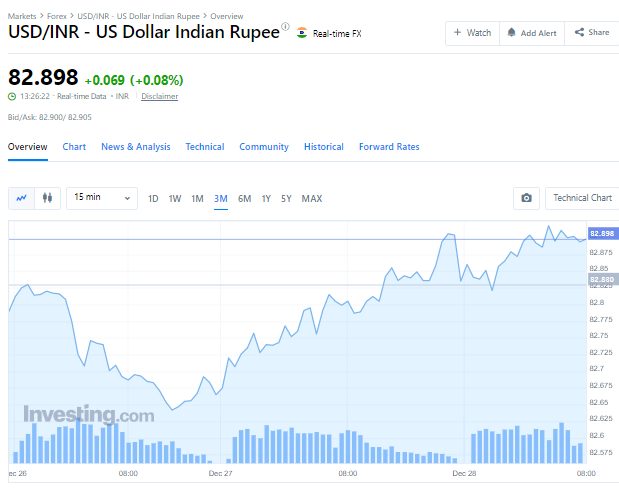
The Rupee is in a free fall against the US Dollar.
However, the RBI is intervening to cushion INR's fall.
Ever wonder how the RBI does it?
Let's learn it here:
#USDINR #USD #forex #India #Rupee
However, the RBI is intervening to cushion INR's fall.
Ever wonder how the RBI does it?
Let's learn it here:
#USDINR #USD #forex #India #Rupee

First, let's understand why RBI intervenes to defend the rupee in the first place.
A weak currency worsens our fiscal deficit, fuels inflation and slows down international trade.
Clearly, RBI has a mandate to improve the situation on behalf of the GoI and the citizens of India.
A weak currency worsens our fiscal deficit, fuels inflation and slows down international trade.
Clearly, RBI has a mandate to improve the situation on behalf of the GoI and the citizens of India.
Forex market is highly volatile and a breeding ground for speculators. This is why the FX market is the most liquid in the world with around $7.5 trillion (with a T!) in daily turnover.
So, RBI has to control speculation in the USDINR segment to ensure stability of the Rupee.
So, RBI has to control speculation in the USDINR segment to ensure stability of the Rupee.
Towards this RBI does four things:
- Limit borrowing by banks
- Increase interest rates
- Increase Cash Reserve Ratios
- Selling USD in the NDF and Spot Markets
The first three are long-term measures and the last one, the most interesting, is a short-term measure.
#trading
- Limit borrowing by banks
- Increase interest rates
- Increase Cash Reserve Ratios
- Selling USD in the NDF and Spot Markets
The first three are long-term measures and the last one, the most interesting, is a short-term measure.
#trading
Our banks love to borrow money from the RBI. Cheap credit fuels expansion in the economy, but at a cost.
So RBI makes this more difficult by increasing costs and capping the borrowings.
This makes banks look at market borrowings for funds, and discourages speculation.
#USDINR
So RBI makes this more difficult by increasing costs and capping the borrowings.
This makes banks look at market borrowings for funds, and discourages speculation.
#USDINR
Increasing interest rates makes it more attractive for foreign investors to #invest in India. This means they will buy more INR to invest in Indian securities and bonds by selling their dollars.
Higher demand for INR = Better value against the USD => USDINR pricing stabilizes
Higher demand for INR = Better value against the USD => USDINR pricing stabilizes
Increasing CRR of banks also helps to make sure the banks don't speculate on the markets with spare cash/foreign currency.
Remember that RBI allows exemptions to this requirement on NRE deposits, thereby encouraging NRIs to send more money to India in foreign currency.
#NRI
Remember that RBI allows exemptions to this requirement on NRE deposits, thereby encouraging NRIs to send more money to India in foreign currency.
#NRI
Finally, the RBI sells USD from its FX reserves in Non-Deliverable Forwards (NDF) and Spot markets, both onshore and offshore.
NDF markets are highly speculative (think Nifty F&O) and offers high arbitrage opportunities between onshore and offshore markets.
#trading #Arbitrage
NDF markets are highly speculative (think Nifty F&O) and offers high arbitrage opportunities between onshore and offshore markets.
#trading #Arbitrage

NDF offshore FX rates trade at a premium to onshore markets (e.g., GIFT City) so speculators bet heavily against the INR to arbitrage trade. RBI sells USD to ensure the arbitrage doesn't exist.
It also sells USD in the spot market to create an artificial demand for the Rupee.
It also sells USD in the spot market to create an artificial demand for the Rupee.
As demand is created for INR in this way by the RBI, spot markets and NDF markets stabilize to cushion the fall of the Rupee in the short term.
Interesting isn't it? Forex markets are cool like that :)
However, this is not enough:
Interesting isn't it? Forex markets are cool like that :)
However, this is not enough:
https://twitter.com/ajay_invests/status/1607238880025247745?s=20&t=dG8ZsYxF9WFVeEWs9kDvpw
India need to expand its export base & find alts to oil to really stop the fall of the Rupee and have a stable currency.
Until then RBI will fire fight for us :)
If you liked this insight, consider liking and RT the first tweet to educate more people 🙂
themoneymemo.substack.com
Until then RBI will fire fight for us :)
If you liked this insight, consider liking and RT the first tweet to educate more people 🙂
themoneymemo.substack.com
• • •
Missing some Tweet in this thread? You can try to
force a refresh





